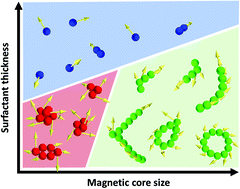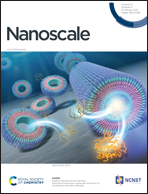Simulated clustering dynamics of colloidal magnetic nanoparticles†
Abstract
Magnetically guided self-assembly of nanoparticles is a promising bottom-up method to fabricate novel materials and superstructures, such as, for example, magnetic nanoparticle clusters for biomedical applications. The existence of assembled structures has been verified by numerous experiments, yet a comprehensive theoretical framework to explore design possibilities and predict emerging properties is missing. Here we present a model of magnetic nanoparticle interactions built upon a Langevin dynamics algorithm to simulate the time evolution and aggregation of colloidal suspensions. We recognise three main aggregation regimes: non-aggregated, linear and clustered. Through systematic simulations we have revealed the link between single particle parameters and which aggregates are formed, both in terms of the three regimes and the chance of finding specific aggregates, which we characterise by nanoparticle arrangement and net magnetic moment. Our findings are shown to agree with past experiments and may serve as a stepping stone to guide the design and interpretation of future studies.



 Please wait while we load your content...
Please wait while we load your content...